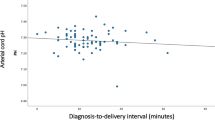Abstract
Objective: To utilize infant outcomes and to identify risk factors associated with umbilical cord prolapse. Materials and methods: Birth records of 80 cases with umbilical cord prolapse and 800 randomly selected controls were reviewed retrospectively. Statistical analysis was performed using logistic regression models. Results: Prolapse of the umbilical cord complicated 0.47% (n=80) of all deliveries included in the study (n=16,874). Multiparity wase more common in patients with umbilical cord prolapse (63.8–49.4%, P=0.014). Umbilical cord prolapse occurred in breech presentation in six cases (7.5%) and in transverse presentation in three of the cases (3.8%). The occurrence of breech presentation among the control cases was 1.0% and of the transverse lie was 0.1% (P<0.001). Fetuses with umbilical cord prolapse had lower fetal weight; particularly, fetal weight less than 2,500 g was a significant risk factor (3–2.4%, P<0.001). We also found that spontaneous rupture of membranes (OR=8.93; 95%, CI=4.16–19.14), Bishop score greater than 8 (OR=5.48; 95%, CI=3.21–9.34), and polyhydramnios (OR=21.0; 95%, CI=11.4–38.7) were risk factors for umbilical cord prolapse. The newborns that were delivered after umbilical cord prolapse graded lower Apgar scores less than 7 at 5 min (6.3–1.4%, P=0.002). Conclusion: Abnormal fetal presentation, multiparity, low birth weight, prematurity, polyhydramnios, and spontaneous rupture of membranes, in particular with high Bishop scores, are risk factors for umbilical cord prolapse. Early amniotomy increases the variable decelerations and hence increases the rate of cesarean section because of fetal distress, but it may prevent pregnant women from umbilical cord prolapse, which has a high mortality rate. However, large randomized trials are needed to prove that early amniotomy decreases the incidences of umbilical cord prolapse.
Similar content being viewed by others
References
Critchlow CW, Leet TL, Benedetti TJ, Daling JR (1994) Risk factors and infant outcomes associated with umbilical cord prolapse: a population based case control study among births in Washington State. Am J Obstet Gynecol 170:613–618
Goffinet F, Fraser W, Marcoux S, Breart G, Moutquin JM, Daris M (1997) Early amniotomy increases the frequency of fetal heart rate abnormalities. Br J Obstet Gynecol 104:548–553
Kahana B, Sheiner E, Levy A, Lazer S, Mazor M (2004) Umbilical cord prolapse and perinatal outcomes. Int J Gynecol Obstet 84:127–132
Katz Z, Shoham Z, Lancet M, Blickstein I, Mogilner BM, Zalel Y (1998) Management of labor with umbilical cord prolapse: a 5 year study. Obstet Gynecol 72:278–282
Koonings PP, Paul RH, Campbell K (1990) Umbilical cord prolapse, a contemporary look. J Reprod Med 35:690–692
Pernoll ML (2002) Umbilical cord prolapse. In: Benson, Pernoll (eds) Obstetrics and Gynecology 10th edn
Roberts WE, Martin RW, Roach HH, Perry KG, Martin JN, Morrison JC (1997) Are obstetric interventions such as cervical ripening, induction of labor, amnioinfusion, or amniotomy associated with umbilical cord prolapse. Am J Obstet Gynecol 176:1181–1185
UK Amniotomy Group (1994) A multicentre randomised trial of amnitomy in spontaneous first labour at term. Br J Obstet Gynaecol 101:307
Uygur D, Kiş S, Tuncer R, Özcan FS, Erkaya S (2002) Risk factors and infant outcomes associated with umbilical cord prolapse. Int J Gynecol Obstet 78:127–130
Yla Outinen A, Heinonen PK, Tuimala R (1985) Predisposing and risk factors of umbilical cord prolapse. Acta Obstet Gynecol Scand 64:567–570
Author information
Authors and Affiliations
Corresponding author
Rights and permissions
About this article
Cite this article
Dilbaz, B., Ozturkoglu, E., Dilbaz, S. et al. Risk factors and perinatal outcomes associated with umbilical cord prolapse. Arch Gynecol Obstet 274, 104–107 (2006). https://doi.org/10.1007/s00404-006-0142-2
Received:
Accepted:
Published:
Issue Date:
DOI: https://doi.org/10.1007/s00404-006-0142-2




